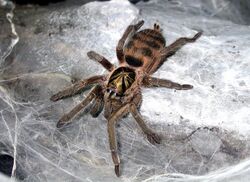Biology:Neoholothele incei
| Neoholothele incei | |
|---|---|

| |
| Neoholothele incei | |
| Scientific classification | |
| Domain: | Eukaryota |
| Kingdom: | Animalia |
| Phylum: | Arthropoda |
| Subphylum: | Chelicerata |
| Class: | Arachnida |
| Order: | Araneae |
| Infraorder: | Mygalomorphae |
| Family: | Theraphosidae |
| Genus: | Neoholothele |
| Species: | N. incei
|
| Binomial name | |
| Neoholothele incei (F.O. Pickard-Cambridge, 1898)[1]
| |
| Synonyms[1] | |
|
Holothele incei (F.O. Pickard-Cambridge, 1898) | |
Neoholothele incei is a species of tarantula from Trinidad and Venezuela,[1] commonly called the Trinidad olive tarantula. When mature, the species has a leg-span exceeding 5–7.5 cm (2.0–3.0 in). As often the case with tarantulas, the females live longer than males, with the former living up to 7 years compared to the 2 years that males can expect to reach. N. incei is a bird spider and is fossorial.[2] It is commonly kept as a pet as it is easy to breed.[3] Rarely for tarantulas, N. incei is known to live communally and cannibalism is rare except for times of extreme hunger.[2] Like most New World species, the venom of N. incei is considered to be mild and comparable to a bee sting, however no research has confirmed this.[2][4]
This species has a golden carapace and its abdomen is striped.
References
- ↑ 1.0 1.1 1.2 "Taxon details Neoholothele incei (F. O. Pickard-Cambridge, 1898)", World Spider Catalog (Natural History Museum Bern), http://www.wsc.nmbe.ch/species/37545, retrieved 2017-09-23
- ↑ 2.0 2.1 2.2 "Neoholothele incei" (in en-US). 2015-09-13. https://www.theraphosidae.be/en/neoholothele-incei/.
- ↑ "Arachnoculture E-Zine :: Issue 1 :: Exotic Fauna". Archived from the original on 2016-03-05. https://web.archive.org/web/20160305025656/http://exoticfauna.com/arachnoculture/1/AC-i1a6-p1.html. Retrieved 2015-12-29.
- ↑ "Trinidad Olive Tarantula (Neoholothele incei)". 2014-08-11. https://www.tarantulasoftheworld.com/trinidad-olive-tarantula-holothele-incei/.
Wikidata ☰ Q4128025 entry
 |

